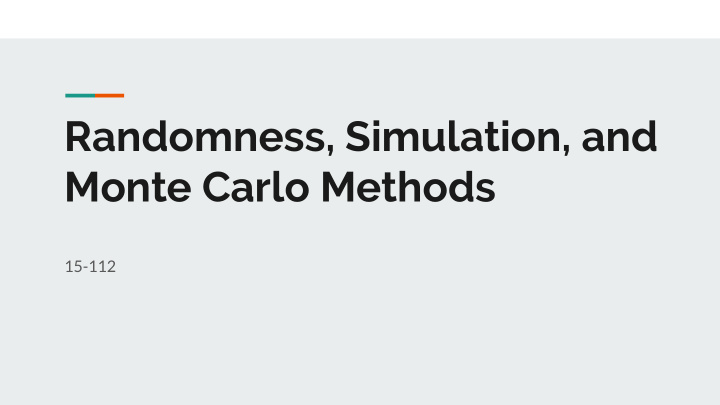



Randomness, Simulation, and Monte Carlo Methods 15-112
Today’s Big Idea Q: What are the odds that five cards drawn from a deck will sum to a prime number? Can we write a program to compute this? So far in the class, we’ve used logic to solve problems. Today we’ll discuss a different tool for problem solving: simulation .
Learning Goals Understand how programs can compute random or pseudo-random numbers computationally Recognize when simulations can be used to learn about systems Use Monte Carlo methods to solve problems
Randomness
Deterministic or Not? So far, we’ve mostly written deterministic algorithms- a given input will always produce the same output. Some algorithms are non-deterministic, or random ; the output may change. What are some examples of problems where we want an algorithm to include randomness?
Features of Randomness It’s hard to directly define randomness, because… it’s random. However, a truly random sequence should not be predictable . There can’t be any patterns. Algorithms are all about patterns! How can a computer generate randomness?
Pseudo-Random Numbers Python’s built-in random library uses an algorithm (the Mersenne Twister) to generate a sequence psuedo-random numbers . These numbers are not truly random, but they are unpredictable enough for everyday use (like Tetris). It still isn’t safe to use most psuedo-random number generators for security purposes- if you can guess the algorithm, it’s no longer random. The best way to generate truly random sequences is to gather physical data (like atmospheric noise or radioactive decay) that cannot be predicted.
Python’s Random Library The random library in Python is secretly deterministic- if you know where you are in the sequence, you can predict what will come next. Use random.seed() to select a specific location in the sequence. All methods in the random library start from random.random() , which generates a number from [0.0, 1.0)
Useful Random Functions random.randint(a, b) - generates a random integer in [a, b] random.choice(lst) - returns a random item in the iterable lst random.shuffle(lst) - shuffles the sequences lst Activity - how would you implement flipping a coin, rolling a die, and drawing a card?
Simulation
Simulation Simulation is the process of modeling an event to determine how it turns out. It’s based on two parts: A model that describes the state of the world Rules that describe how the world changes over time Our time-based animations are simulations!
Simulations in Many Disciplines Simulations are used in many different fields to study different subjects. You can find some great examples on NetLogo: Fireworks ● Ants ● Infection Rates ● Waves ● Fire ● Traffic ●
Law of Large Numbers One simulation is just an example. But the more simulations you run, the closer their average will be to the true expected value. Therefore, by running lots of simulations and averaging them, we can simulate the truth .
Monte Carlo Methods
Monte Carlo Methods A Monte Carlo method is an algorithm that uses a series of simulations to approximate the answer to a problem. It’s gambling with the accuracy of its answer! Fun fact: a Las Vegas algorithm also uses randomness, but gambles with runtime, not accuracy.
Monte Carlo Algorithm Template def simulate(trials): count = 0 for trial in range(trials): # Run a large number of trials result = runTrial() # simulate a random event each time if result == True: # count the number of successful events count += 1 return count / trials # calculate the observed outcome
Let’s code it! Let’s use a Monte Carlo method to solve our Poker prime number question...
Time vs. Accuracy The more trials we run, the more accurate our estimate will be. But the more trials we run, the longer our code will take to run! Determining how many trials to use is always a balance between these two factors.
You do! Every year, CMU holds the Random Distance Race. At the start of the race, one giant die is thrown, and racers must run that many laps. As soon as the first racer finishes those laps, a second die is thrown, and everyone must run that many more laps. Question: how often will someone need to run 10 or more laps at the Random Distance Race?
If time Monte Carlo methods can be used to solve lots of cool and non-intuitive math problems, including… The Birthday Problem ● The Monty Hall Problem ● Calculating Pi on a desert island ●
Learning Goals Understand how programs can compute random or pseudo-random numbers computationally Recognize when simulations can be used to learn about systems Use Monte Carlo methods to solve problems
Recommend
More recommend